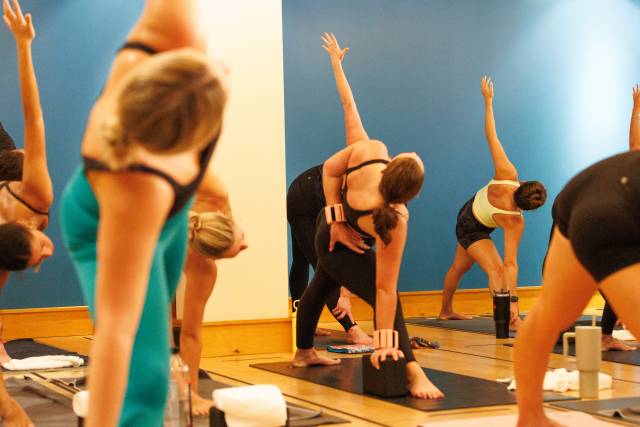College students are no stranger to stress and anxiety. The pressure of exams, deadlines, and social expectations can often feel overwhelming. But what if there was a way to find calm amidst the chaos? Enter yoga – an ancient practice that’s gaining modern recognition for its ability to soothe anxious minds and bodies. In this blog post, we’ll explore how yoga can be a powerful tool in managing anxiety, and we’ll dive into specific poses and breathing exercises that you can easily incorporate into your daily routine.
The connection between yoga and anxiety relief is more than just anecdotal. Research has shown that regular yoga practice can significantly reduce symptoms of anxiety and stress. This mind-body practice combines physical postures, breathing techniques, and meditation to create a holistic approach to wellness. For college students juggling multiple responsibilities, yoga offers a much-needed respite and a chance to reconnect with yourself.
Proper Breathing: The Foundation of Your Yoga Practice
One of the most beautiful aspects of yoga is its accessibility. You don’t need expensive equipment or a gym membership to get started. All you need is a quiet space, comfortable clothes, and an open mind. Whether you’re in your dorm room, a study lounge, or a nearby park, you can practice yoga anywhere.
Let’s start with breathing exercises, also known as pranayama in yoga. Proper breathing is the foundation of any yoga practice and is especially beneficial for anxiety relief. One simple yet effective technique is called “box breathing” or “square breathing.” Here’s how it works: Imagine tracing a square with your breath. Inhale for a count of four, hold your breath for four counts, exhale for four counts, and then hold your breath out for four counts. Repeat this cycle for a few minutes. This regulated breathing pattern helps activate your parasympathetic nervous system, which is responsible for the “rest and digest” state, as opposed to the “fight or flight” response often triggered by anxiety.
Another powerful breathing exercise is the “alternate nostril breathing” or “Nadi Shodhana.” This technique helps balance the left and right hemispheres of your brain, promoting a sense of calm and clarity. To practice, use your right thumb to close your right nostril and inhale deeply through your left nostril. At the peak of your inhalation, close your left nostril with your ring finger, release your thumb, and exhale through your right nostril. Then, inhale through the right nostril, close it, and exhale through the left. This completes one cycle. Continue for several minutes, focusing on the smooth flow of your breath.
Yoga Poses for Anxiety Relief
Now, let’s move on to some yoga poses, or asanas, that are particularly beneficial for anxiety relief. Remember, the goal isn’t to achieve perfect form but to connect with your body and breath. Listen to your body and never push yourself to the point of pain or discomfort.
Child’s Pose, or Balasana, is a gentle, restorative pose that can help you feel grounded and safe. To practice, kneel on the floor, sit back on your heels, and fold forward, extending your arms in front of you or alongside your body. Rest your forehead on the mat and breathe deeply. This pose gently stretches your back and hips while providing a sense of security and calm.
The Standing Forward Bend, or Uttanasana, is another excellent pose for anxiety relief. From a standing position, hinge at your hips and fold forward, allowing your upper body to hang heavy. You can bend your knees if needed to release tension in your lower back. This pose helps calm the nervous system and can provide relief from headaches and fatigue – common side effects of anxiety.
For a more active pose that can help channel anxious energy, try the Warrior II pose, or Virabhadrasana II. Stand with your feet wide apart, turn your right foot out 90 degrees, and your left foot in slightly. Bend your right knee over your ankle, extend your arms out to the sides, and gaze over your right fingertips. This pose builds strength and confidence while encouraging deep, steady breathing.
The Legs-Up-the-Wall pose, or Viparita Karani, is a restorative pose that’s perfect for when you’re feeling overwhelmed. Sit sideways against a wall, then lie back and swing your legs up the wall. Rest here for several minutes, focusing on your breath. This gentle inversion can help calm your mind and relieve tension in your legs and lower back.
Finally, let’s talk about Savasana, or Corpse Pose. While it might seem counterintuitive to lie still when you’re feeling anxious, this pose is crucial for integrating the benefits of your practice. Lie on your back, arms at your sides, palms facing up. Close your eyes and focus on relaxing each part of your body, from your toes to the crown of your head. Stay here for at least five minutes, allowing yourself to fully relax.
Consistency is the Key to Everything
As you incorporate these poses and breathing exercises into your routine, remember that consistency is key. Even just 10-15 minutes of daily practice can make a significant difference in managing your anxiety levels. You might find it helpful to set a specific time each day for your yoga practice, such as first thing in the morning or as a study break in the afternoon.
It’s also worth noting that yoga isn’t just about the physical practice. The philosophical aspects of yoga, such as mindfulness and non-judgment, can be powerful tools in managing anxiety. As you practice, try to cultivate a sense of acceptance for whatever arises – whether it’s physical sensations, thoughts, or emotions. This non-judgmental awareness can help you develop a healthier relationship with your anxiety, seeing it as a temporary state rather than a defining characteristic.
For college students, the benefits of yoga extend beyond anxiety relief. Regular practice can improve focus and concentration, enhance sleep quality, and boost overall physical health. It can also provide a sense of community if you choose to attend group classes, which can be a great way to connect with like-minded individuals and combat the isolation that sometimes comes with anxiety.
Remember, while yoga can be a powerful tool for managing anxiety, it’s not a substitute for professional help if you’re struggling with severe or persistent anxiety. Many colleges offer counseling services, and it’s always okay to reach out for additional support.
A Holistic Approach to Managing Anxiety
As you embark on your yoga journey, be patient and kind to yourself. Like any skill, it takes time to develop a yoga practice. Some days will feel easier than others, and that’s perfectly normal. The most important thing is to show up on your mat, connect with your breath, and give yourself the gift of presence.
In conclusion, yoga offers a holistic approach to managing anxiety that’s particularly well-suited to the college lifestyle. By incorporating breathing exercises and yoga poses into your daily routine, you’re not just treating the symptoms of anxiety – you’re developing lifelong tools for stress management and self-care. So roll out your mat, take a deep breath, and start your journey towards a calmer, more centered you. Your mind and body will thank you.







